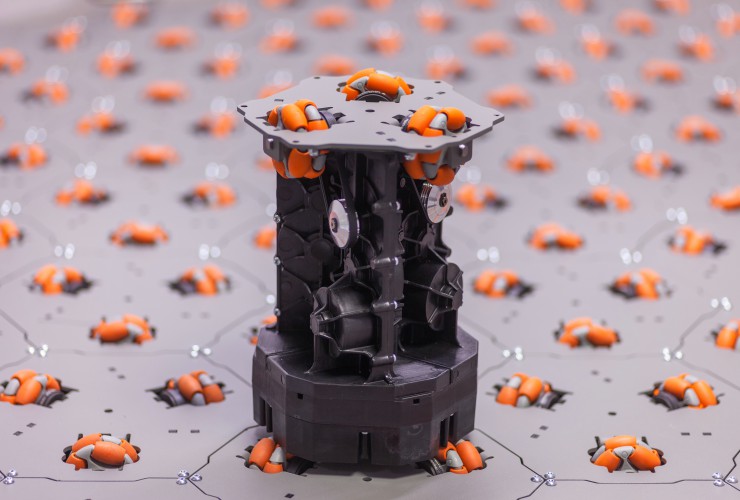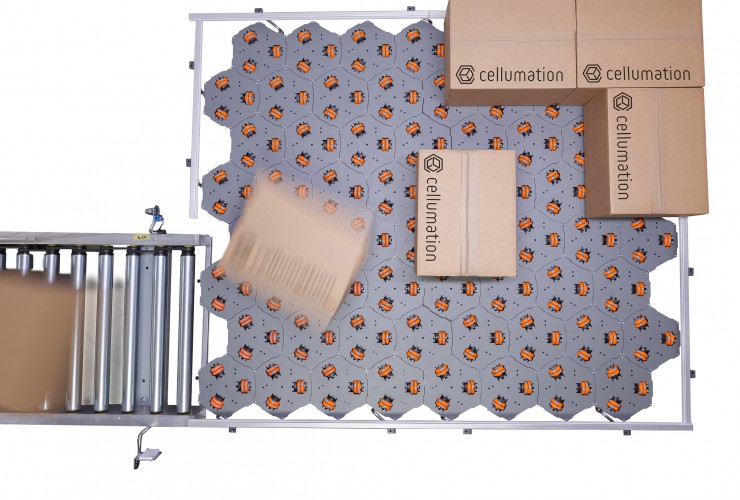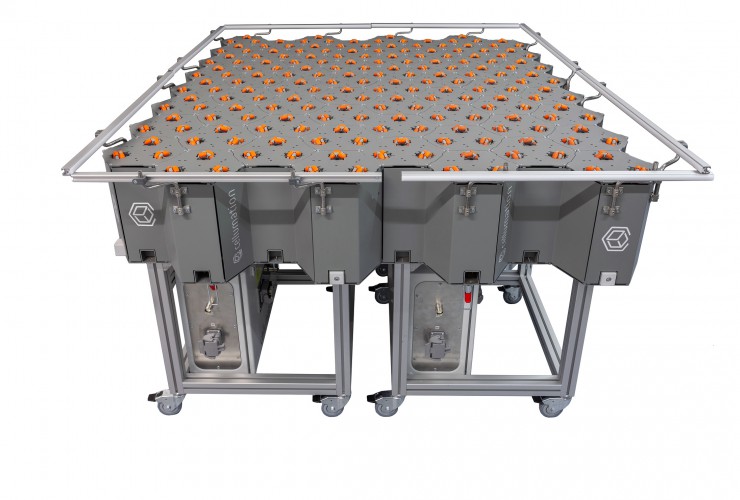IFOY Schirmherrschaft
IFOY Träger
IFOY Partner
celluveyor
cellumation
IFOY-Kategorie
Start-up of the Year
Zusammenfassung
Wir haben Fußballroboter auf den Kopf gestellt und lassen auf ihren Rollen Pakete in alle Richtungen bewegen: Ein celluveyor besteht aus mehreren hexagonalen Zellen, die sich wie LEGO®-Steine zu beliebigen Maschinen zusammenklicken lassen. Der celluveyor kann alle Aufgaben der Fördertechnik realisieren, wobei die Funktion allein durch die Software definiert wird. So können Warenflüsse jederzeit auf Knopfdruck angepasst und enorme Platzeinsparnisse erzielt werden.
Beschreibung
Ein celluveyor ist ein modulares Materialflusssystem, das aus hexagonalen Zellen besteht, die zu einem beliebigen Layout zusammengefügt werden. Auf der celluveyor-Oberfläche können Pakete dank omnidirektionaler Räder flexibel bewegt und positioniert werden. So können selbst komplexe Materialflussaufgaben realisiert werden - beispielsweise können aus einzelnen Paketen Lagen für automatische Palettieranwendungen gebildet werden.
Komplexe Anwendungen werden für den Kunden zum Kinderspiel: der celluveyor kann durch die Installation neuer Software - vergleichbar mit Apps auf einem Handy - programmiert und konfiguriert werden. Dafür sind keine Programmierkenntnisse erforderlich und jeder, der ein Handy bedienen kann, kann ein celluveyor-System steuern.
Die Technologie kann in allen Stationen einer Materialflusskette eingesetzt werden, wo eine komplexere Bewegung als einfaches „Geradeausfahren“ von Objekten notwendig ist. So sind besonders Logistikzentren, aber auch Produktionszentren, in denen Pakete bewegt werden, Haupteinsatzorte für den celluveyor. Auch bei Maschinenherstellern, die plattenförmiges Material, wie Holz, Glas oder Blech befördern oder bearbeiten, kann der celluveyor optimal eingesetzt werden.
Die celluveyor-Zelle ist das zentrale Element der Technologie - diese ist unabhängig von der Anwendung immer identisch und kann in hohen Stückzahlen produziert werden. Somit werden sehr hohe Skalierungseffekte erreicht.
Bewerbungsdaten
Innovation
Herkömmliche Materialflusssysteme sind dafür konzipiert, eine bestimmte Funktion zu erfüllen und eine optimale Leistung bei Spitzenauslastungen zu erbringen. Die Mehrheit der konventionellen Systeme bewegt Objekte in vordefinierten Bahnen. Solche Systeme bestehen aus Hunderten von Komponenten für lineare Bewegungen und aus Knotenpunkten für alle Spezialfunktionen (wie z.B. Rotation). Um Spitzenvolumina effizient und zuverlässig abdecken zu können, werden die Systeme oft größer gebaut, als sie sein müssten. Sie sind „zuverlässige Arbeitstiere“ für relativ einfache, unveränderliche Aufgaben. Sie können aber nicht die heutzutage benötigte Multifunktionalität und Flexibilität bieten. Sie sind daher sehr unflexibel, kapitalintensiv, benötigen viel Platz und viele Ersatzteile.
Im Gegensatz dazu ist der celluveyor eine modulare, multi-funktionale Materialflusstechnik, die einen völlig neuen Ansatz darstellt: Statt eines starren, mechanischen Förderbandes, das für eine einzige, unveränderliche Aufgabe konzipiert ist, kann der celluveyor mit wenigen Klicks auf Knopfdruck (neu) konfiguriert werden – die Bewegungen sind "mechanisch entkoppelt" und werden alleine durch Software gesteuert. Der celluveyor benötigt bis zu 95 Prozent weniger Platz als herkömmliche Materialflusstechnik und die Ersatzteile sind auf ein einziges Element reduziert: die Zelle. Er ist im Vergleich zu den traditionellen Systemen flexibler, kostengünstiger und kann kurzfristig geliefert werden.
Marktrelevanz
Der Hauptwachstumsmotor in diesem Markt ist der E-Commerce und das damit verbundene sich ändernde Kaufverhalten der Kunden. Es wird erwartet, dass sich dieses Wachstum fortsetzt – für die fünf Jahre 2018-2023 kann mit einer CAGR von 17 Prozent auf 5,9 Mrd. € an globalen E-Commerce-Einzelhandelsumsätzen gerechnet werden.
Der relevante Markt des celluveyor ist der Markt für Materialflusstechnik. Branchenquellen schätzten die Größe des relevanten globalen Teilsegments der Stetigförderer auf 33,5 Mrd. € im Jahr 2016 (davon EU: 13,2 Mrd. €) und prognostizierten ein deutliches Wachstum (CAGR 9,9 Prozent). Dabei stellen Produktions- und Logistikunternehmen die Hauptabnehmer von Materialflusssystemen dar, wobei die Hauptzielgruppe Systemintegratoren sind, die komplette Systeme für Produktions- und Logistikunternehmen installieren. Sekundäre Zielgruppen sind Logistik- und Produktionsunternehmen, sowie Originalausrüstungshersteller. Die cellumation GmbH hat bereits verschiedene Pilot-Projekte mit wichtigen Kunden erfolgreich realisiert, zudem sind mehrere Systeme im industriellen Einsatz und die Sales-Pipeline ist gefüllt.
Hauptvorteile für den Kunden
Die Hauptvorteile für die Kunden sind:
- Layoutflexibilität: Der celluveyor kann in jeder Form gebaut werden, was eine große Flexibilität hinsichtlich des Layouts bedeutet. Der celluveyor kann problemlos in existierende Systeme mit festem Layout integriert werden.
- Investitionssicherheit: Der celluveyor kann für alle Förderfunktionen verwendet werden. Die Funktionalität kann mit wenigen Klicks auf einem Laptop oder Tablet (neu) konfiguriert werden. Auf Bedarfsänderungen eines Kunden (verändertes Volumen, veränderte Paketgrößen, neue Services) kann problemlos eingegangen werden und Kundeninvestitionen sind nachhaltig sicher.
- Niedriger Platzbedarf: Der celluveyor benötigt für komplexe Anwendungen bis zu 95 Prozent weniger Platz im Vergleich zu herkömmlichen Systemen.
- Plug & Play-Prinzip: Es wird keine zeitaufwändige Integration und Programmierung von statischen Logiksteuerungen benötigt – der celluveyor hat eine automatische Layouterkennung und die einzelnen Zellen kommunizieren direkt miteinander. So erfolgt die Inbetriebnahme des celluveyor innerhalb kürzester Zeit.
- Einfache & kostengünstige Wartung: Der celluveyor hat ein einziges Ersatzteil: die Zelle. Diese kann innerhalb von Minuten von Werkspersonal des Kunden ausgetauscht werden. So können längere Systemausfälle vermieden werden, das Ersatzteillager ist minimal und es entstehen kaum Wartungskosten.
Technische Daten
Video: celluveyor - application for the IFOY award
IFOY Innovation Check
IFOY Innovation Check
Marktrelevanz
Die Bereitstellung von Behältern, Kartons und Boxen im Rahmen der Palettierung sowie das Auflösen von Lagen bei der Depalettierung sind von hohem Interesse bei einer Vielzahl von Applikationen in Industrie und Handel.
Kundennutzen
Cellumation bietet hierfür mit seinem Produkt celluveyor eine Lösung an, die sehr weitreichend modularisiert aufgebaut ist und damit bei hoher Flexibilität einen hohen Grad von Standardisierung erlaubt. Es sind freie Bewegungen innerhalb der Ebene möglich und das System verfolgt die Ladungen selbständig nach. Auch Eingriffe und Störungen können weitreichend robust abgefangen werden.
Neuheitsgrad
Gerade der modulare Aufbau ist neuartig. Durch die Zusammenarbeit der Module können fast freie Flächenbewegungen der Behälter durchgeführt werden. Durch den hohen Standardisierungsgrad können auch ausgefallene Module sehr leicht ausgetauscht werden und müssen anschließend nicht neu justiert oder in Betrieb genommen werden.
Funktionalität / Art der Umsetzung
Der Förderer zeigt sich robust und industrietauglich, macht optisch wie technisch einen sehr hochwertigen Eindruck. Allerdings sind die Einsatzfälle auf das (Lagen-)Palettieren und Depalettieren beschränkt, so dass die wirtschaftliche Bedeutung und der breite Einsatz nicht abgeschätzt werden können.
Fazit
Sehr innovatives Förderprinzip mit hoher Flexibilität. Die Anlage schafft eine beeindruckende Performance - selbst bei einem manuellen Eingriff als „Störung". Das System ist raumsparend.
Insgesamt sind die Einsatzmöglichkeiten eingeschränkt. Vermutlich ist das System schwer wirtschaftlich einsetzbar.
|
Marktrelevanz |
+ |
|
Kundennutzen |
+ |
|
Neuheits- / Innovationsgrad |
++ |
|
Funktionalität / Art der Umsetzung |
++ |
|
++ sehr gut / + gut / Ø ausgeglichen / - weniger / - - nicht vorhanden |
|
celluveyor
cellumation
IFOY category
Start-up of the Year
Summary
We have turned soccer robots upside down and with their wheels we freely move packages in any direction: A celluveyor consists of several hexagonal cells that can be clicked together like LEGO® bricks to form any system layout. The celluveyor can realize all tasks of conveyor technology and the function is solely defined by the software. Clients can adapt material flow systems at any time at the push of a button, achieve enormous space savings and are able to easily create new processes.
Description
A celluveyor is a modular material flow system consisting of hexagonal cells, which can be assembled to any layout. On the celluveyor surface, packages can be moved and positioned flexibly thanks to omnidirectional wheels. Thus, even complex material flow tasks can be realized - for example, the celluveyor can receive individual packages and form layers for automatic palletizing systems.
Complex applications become a piece of cake for customers: the celluveyor can be programmed and configured by installing new software - similar to apps on a smartphone. No programming knowledge is required and anyone who can use a smartphone can control a celluveyor system.
The technology can be used in all stations of a material flow chain where a more complex movement than simply "straight ahead" is required. Especially logistics centers, but also production centers, in which packages are moved, are the main operation area for the celluveyor. The celluveyor can also be optimally used by machine manufacturers who transport or process plate-like material such as wood, glass or metals.
The celluveyor cell is the central element of the technology - it is always identical regardless of the application and can be produced in large quantities. Thus, very high scaling effects are achieved.
Entry Data
Innovation
Conventional material handling systems are designed to perform a specific function and provide optimum performance at peak loads. Most conventional conveyor systems move objects in predefined paths. Such systems consist of hundreds of components for linear movement and nodes for all special functions (such as rotation). To cover peak volumes efficiently and reliably, systems are often built larger than they need to be. They are "reliable workhorses" for relatively simple, unchanging tasks. However, they cannot provide the multifunctionality and flexibility required today. They are therefore very inflexible, capital-intensive, take up a lot of space and require a lot of spare parts.
In contrast, the celluveyor is a modular, multi-functional material flow system that represents a completely new approach: instead of a rigid, mechanical conveyor belt designed for a single, unchanging task, the celluveyor can be (re)configured with a few clicks at the touch of a button - rotation and linear movements are "mechanically decoupled" and are controlled solely by software. The celluveyor requires up to 95 percent less space than conventional material flow systems and the spare parts are reduced to a single element: the cell. Compared to traditional systems, it is more flexible, less expensive and can be delivered at short notice.
Marktet relevance
The main growth driver in this market is e-commerce and associated changes in customer purchasing behaviour. This growth is expected to continue - for the five years 2018-2023 at a CAGR of 17 percent to €5.9 billion in global e-commerce retail sales.
The relevant market for the celluveyor is the market for material flow technology. Industry sources estimated the size of the relevant global subsegment of continuous conveyors at € 33.5 billion in 2016 (of which EU: € 13.2 billion) and forecast significant growth (CAGR 9.9 percent). Manufacturers and logistics companies are the main customers for material flow systems, with the main target group being system integrators who install complete systems for manufacturing and logistics companies. Secondary target groups are logistics operators, OEMs and manufacturers. cellumation has already successfully implemented various pilot projects with key customers, several systems are in industrial use and the sales pipeline is filled.
Main customer benefits
The main advantages for the customers are:
- Layout flexibility: The celluveyor can be built in any shape, which means unique layout flexibility. Thanks to this flexibility, the celluveyor can be easily integrated into existing systems even when they have a fixed layout.
- Security of investment: The celluveyor can be used for all conveyor functions. The functionality can be (re)configured with a few clicks on a laptop or tablet. Changes in a customer's requirements (changed volume, changed package sizes, new services, etc.) can easily be accommodated and customer investments are sustainably secured.
- Low space requirements: The celluveyor requires up to 95 percent less space compared to conventional systems for complex applications.
- Plug & Play principle: No time-consuming integration and programming of static logic controls is required - the celluveyor counts with automatic layout recognition and the individual cells communicate directly with each other. This allows a quick set up of the celluveyor.
- Simple & cost-effective maintenance: The celluveyor has only a single spare part: the cell. This can be replaced within minutes by the customer's factory staff. In this way, longer system failures can be avoided, the spare parts stock is minimized and there are almost no maintenance costs.
Technical data
Video: celluveyor - application for the IFOY award
IFOY Innovation Check
IFOY Innovation Check
Market relevance
The provision of totes, cartons and boxes as part of the palletizing process as well as the breaking up of layers during depalletizing are of great interest for a wide range of applications in industry and trade.
Customer benefit
With its celluveyor product, Cellumation offers a solution which is very extensively modularised and thus allows a high degree of standardisation with a high degree of flexibility. Free movements are possible and system tracks charges by itself. Interventions and disturbances can also be intercepted in a far-reaching robust manner.
Novelty
Especially the modular design is innovative and due to the cooperation of the modules almost free surface movements of the containers can be carried out. Due to the high degree of standardization, even failed modules can be replaced very easily and do not have to be readjusted or put into operation afterwards.
Functionality / type of implementation
The conveyor is robust and suitable for industrial use and makes a very high-quality impression both visually and technically. However, the applications are limited to (layer) palletizing and depalletizing, so that the economic importance and the wide application cannot be estimated.
Conclusion
Very innovative conveying principle with high flexibility. The system achieves an impressive performance - even with manual intervention as a "malfunction". The system is space-saving.
All in all, the application possibilities are limited. Probably the system is difficult to use economically.
|
Market relevance |
+ |
|
Customer benefit |
+ |
|
Degree of novelty / innovation |
++ |
|
Functionality / Type of implementation |
++ |
|
++ very good / + good / Ø balanced / - less / - - not available |
|
















